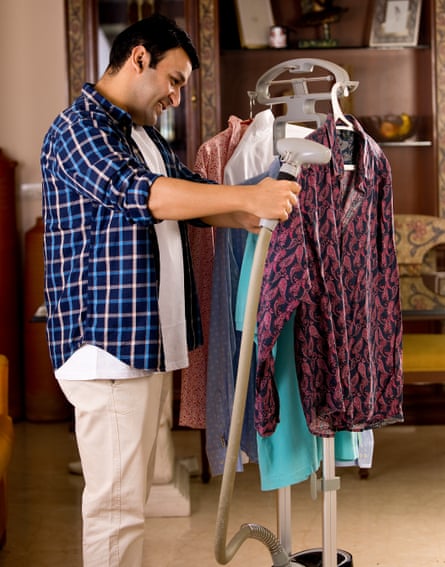
When it comes to clothing care, a garment steamer is one of the most useful investments you can make. My steamer is a godsend when I’m in a rush and the outfit I want to wear needs a refresh. It’s really as simple as pulling it from my wardrobe and running the steamer over it while it’s still on the hanger.
I often use it in place of a wash or dry cleaning, since steam can help lift water marks left by spot cleaning and odours left by cooking or smoke. When I’m travelling, I even find the process of unpacking and steaming each garment a good cure for jetlag.
I have an Esteam travel steamer by Jiffy. I’ve owned it for about 10 months and its only problem has been a build up of calcium inside the water tank, which requires a relatively simple cleaning process to fix.
It’s small and light which makes it easy to fit into a bag, but its size means it can only steam a few garments at a time. This generally suits me (I’m single, I don’t have kids and I travel a lot), but I’m often tempted to buy a freestanding steamer with more power and different settings too. Here, experts unpack the pros and cons of garment steamers.
Steamers v irons
If you’re used to ironing, it’s likely you’ll find a steamer a bit of a revelation.
Steamers are easier to use than irons, more versatile and can be particularly useful when you need to leave the house quickly, says Chris Wilson, of department store David Jones. They’re also better for delicate fabrics such as silk and wool.
The benefits extend beyond convenience, says Kim Gilmour of consumer testing and advocacy group Choice. “Steam can banish bacteria and odours without harsh chemical cleaners if you hold it continuously against the fabric for long enough.” And a steamer can be used around the house, on things like upholstery, curtains and rugs.
But if you need to get creases out of heavier weight fabrics such as denim and cotton drills, or stiffer materials like linen and organza, Gilmour says an iron will give you better results.
after newsletter promotion
Freestanding or handheld?
Generally, steamers can be divided into two categories: freestanding models with large tanks, and handheld steamers that keep their water reservoir in the handle.
Handheld steamers tend to be cheaper and more portable, while freestanding models tend to be more powerful, can be used for longer in a single session, and typically have more features.
Expensive freestanding models feature temperature controls and heat up quickly, says Wilson, which makes them more time-efficient.
Some freestanding steamers also come with somewhere for you to place your clothes, like a board or a coat hanger, and wheels that make them easier to move around the house. But Gilmour points out that all of these features make them heavy, bulky and not suitable for travel.
Because handheld models – which can be packed into a suitcase – store water in the handle, Gilmour says they can start to feel heavy during use and they also require more frequent refills. If you regularly need to steam 20 dresses in a row, you’re much better off with a freestanding steamer.
Bells and whistles
If you’reafter the most deluxe steamer possible, there are a few bells and whistles to keep an eye out for.
Brush attachments can help open up the fibres of thicker clothes such as coats, and some steamers come with special attachments for pleats or creases, larger heads to cover more of the garment, and variable steam settings so you can control steam levels to best suit different fabrics. If you’re in the market for an iron as well, you can also buy an all-in-one steamer, which includes a regular ironing mode – though these run upwards of $500 from reputable brands.
Ultimately your decision should be dictated by how much steaming you’ll do. Wilson says the more expensive steamers tend to last longer and work better, but if you will only steam clothes occasionally, or won’t be steaming a large number of garments in a single session, you’re better off with a cheaper option.
Choice comprehensively tested 15 handheld and freestanding garment steamers available in Australia, and while their reviews and recommendations are available only to subscribers, overall the products performed well, with the lowest-rated steamer receiving a “good” rating.
Try to read the instructions before purchasing any steamer though, as some models recommend against using tap water, which really undermines the free and easy nature of steaming garments as you’re running out the door.



